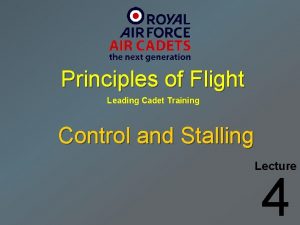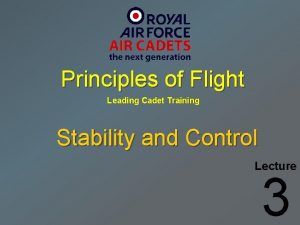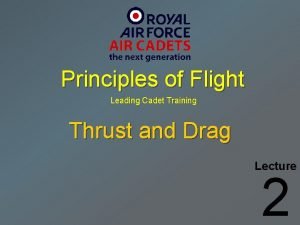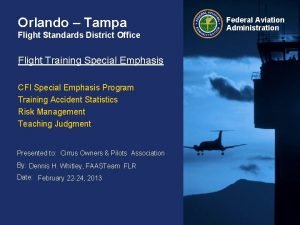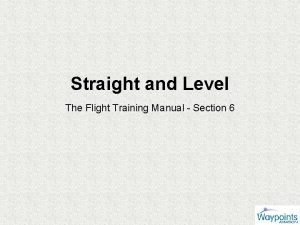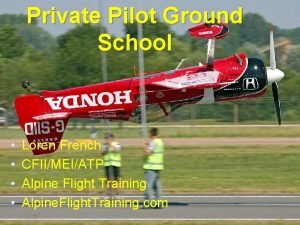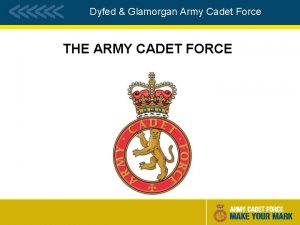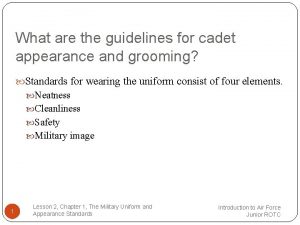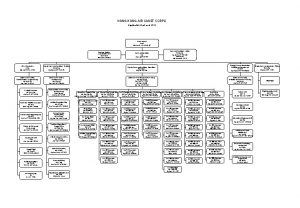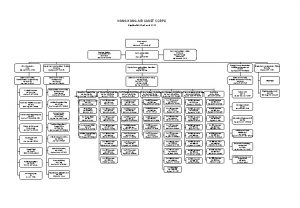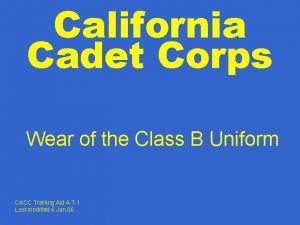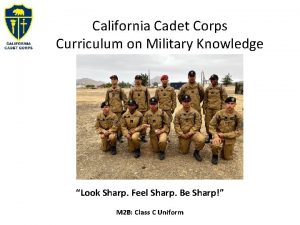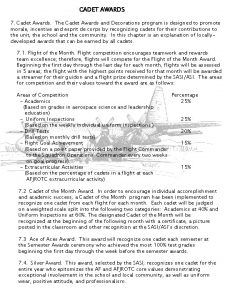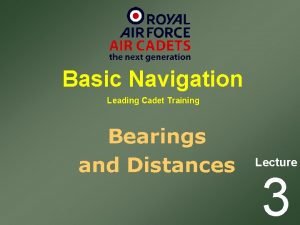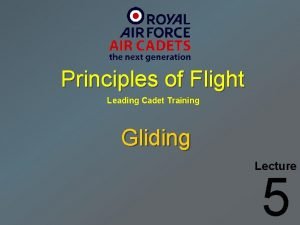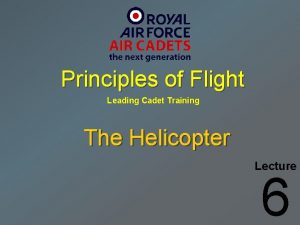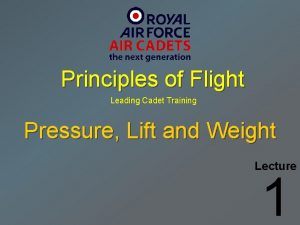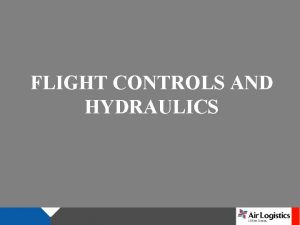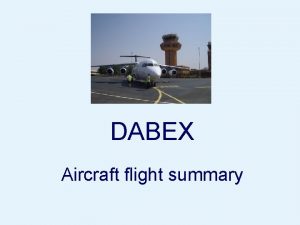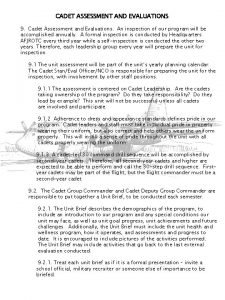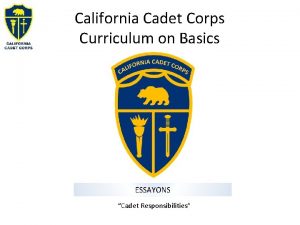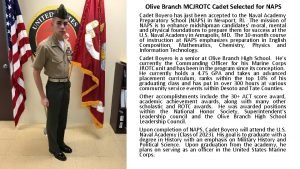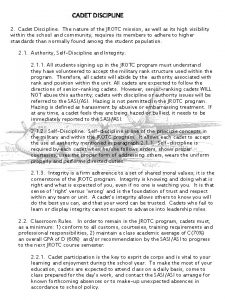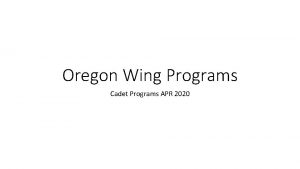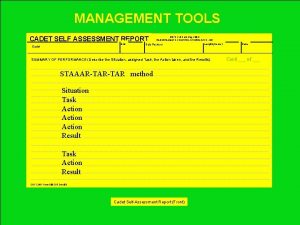Principles of Flight Leading Cadet Training Control and

































- Slides: 33

Principles of Flight Leading Cadet Training Control and Stalling Lecture 4

Trimming Tabs The weight and position of an aircraft’s Centre of Gravity can change when Fuel is used, Bombs dropped, Ammunition fired, etc. and the aircraft will begin to climb. These changes will affect the balance of forces on the aircraft. Trimming Tabs (on to the trailing edges of the elevators, ailerons and rudder), are used to cancel out the unwanted forces on a pilots controls

Flaps A designer needs one shape of wing for the highest possible flying speed – but another for the slowest possible landing speed. A solution is to add flaps to the trailing edge of wings before the ailerons. Plain Flap (or Camber) Simple Flap Split Flaps Blown Flap Fowler Flap

Flaps Drag Effects of Flaps o Flaps 30 90 60 Flap Lift Drag 30 o 60 o 90 o Large Increase Small Increase No Increase Small Increase Large increase V Large increase Flaps are set at 15 o for a short take-off but to obtain the maximum drag from an aircraft's flaps, they should be set to 90 o

Slats Are small aerofoils positioned along the leading edge of each wing, to improve handling at low speeds. If the wing reaches a high angle of attack, the slat opens. Air can now flow between the slat and the wing. Slats Slat Wing Section Flap

The Stall Oncoming air meets the wing at an angle of attack. The more the pilot increases the angle of attack, the more lift there will be, until an angle of about 15° is reached, when the airflow becomes turbulent and lift is lost – so the aircraft STALLS. 15 o α

The Stall This Critical Angle (the stalling angle of attack) varies from one type of wing to another, as does the stalling speed. But the angle of attack is always the same, and not variable, for any particular wing at the point of stall. 15 o α

The Stall This Critical Angle (the stalling angle of attack) varies from one type of wing to another, as does the stalling speed. And a pilot know when he is flying at the optimum angle of attack by reference to the indicated airspeed. 15 o α

The Stall Airflow turbulence is called Boundary Layer Separation at a Low Angle of Attack AIRFLOW MINIMAL SEPARATION Boundary Layer Separation at a Medium Angle of Attack AIRFLOW SEPARATION POINT Boundary Layer Separation at a Stall !! AIRFLOW SEPARATION POINT COMPLETE SEPARATION

Stalling Speed The main factors which affect the stalling speed are: Speed Weight ‘G’ Force Ice & Damage Flaps & Slats

Stalling Speed The Effect of Speed The airspeed at which an aircraft stalls does vary (Details of individual aircraft stalling speeds are found in the Pilot’s Notes/Aircrew Manual etc. ) But putting an aircraft into a turn always increases the stalling speed The Effect of Weight If we increase weight, we must increase the Lift to maintain height. For a particular type of aircraft, a reduction in weight will reduce the stalling speed.

Stalling Speed The Effect of ‘G’ When you pull ‘g’, the stalling speed increases, e. g. if you pull 4 g the stalling speed doubles !! If you pull 9 g the stalling speed triples !!! The Effect of Ice & Damage Ice alters the ‘Shape’ of the wing, this will reduce Lift. Damage can also reduce Lift ie after a ‘Birdstrike’ etc.

Stalling Speed The Effect of Flaps & Slats Basic Situation Flaps ‘Clean’ Lowered and/or Slats Open Chord Lin e α Relative Airflow When flaps or slats areinopen wing, Effective Increase Angleonofa. Attack. both the stalling angle and stalling speed Airflow are between slat and wing. reduced.

Stall Warnings Natural Stall Warning Turbulent Air Missing Tailplane NORMAL FLIGHT Turbulent Air just touching Tailplane STALL WARNING - LIGHT BUFFETING Turbulent Air Covering Tailplane Aircraft Descending STALL WARNING - HEAVY BUFFETING

Stall Warnings Standard Stall Recovery Move stick centrally forward until the buffeting stops. Open throttle at the same time. Only then level the wings. Raise nose at a safe speed and climb.

Check of Understanding If an aircraft in steady straight and level flight suffered a sudden reduction in weight (for example by jettisoning fuel) and the pilot made no changes to the controls the aircraft would begin to? Climb Speed Up Descend Slow Down

Check of Understanding On this cross-section of a wing, which letter points to a Slat? U T S R And what does Letter ‘U’ represent? A Flap

Check of Understanding To obtain the maximum drag from an aircraft's flaps, they should be set to? 60 o 40 o 90 o 10 o

Check of Understanding What is the purpose of trimming tabs on flying controls? To improve handling at low speeds To cancel out the unwanted forces on the pilots controls To increase the approach angle during landing To obtain the maximum drag

Check of Understanding Which statement about airflow over a wing of an aircraft just beyond the point of stall is true? It becomes turbulent It speeds up tremendously It becomes very smooth It stops completely

Check of Understanding On the diagram, what does the arrow point at? The elevator trimming tab The rudder trimming tab The fin The aileron

Check of Understanding Which of these flap settings would a pilot most probably select, for a shorter take-off? 15 o 30 o 45 o 60 o

Check of Understanding A designer needs one shape of wing for the highest possible flying speed – but another for the slowest possible landing speed. What enables one wing to achieve both? Elevators Flaps Trimming Tabs Slats

Check of Understanding When slats are open on a wing what effect will this have on the stalling angle and stalling speed? Increase / Reduce / Increase Reduce / Reduce

Check of Understanding Which of these diagrams represents a Simple Flap? W Y X Z And which represents a Split Flap? W Y X Z

Check of Understanding The angle of attack at which a wing stalls is known as? Separation Angle Warning Angle Boundary Angle Critical Angle

Check of Understanding Which of these is always the same at the point of stall for a particular wing? Its angle of attack Its speed through the air Its angle above the horizon Its wing load

Check of Understanding How does a pilot know when the aircraft is flying at the optimum angle of attack? By reference to the indicated airspeed By visibly checking the horizon along the longitudinal axis By checking the pilot's notes By visibly checking the horizon along the lateral axis

Check of Understanding For a particular type of aircraft, what will reduce the stalling speed. A reduction in weight A reduction in power Putting the aircraft into a turn Raising the flaps

Check of Understanding At the stall of any particular wing which of these factors is NOT variable? The amount of weight supported by the wing The angle of attack of the wing The amount of lift produced by the wing The airspeed across the wing

Check of Understanding Which of the following will increase the stalling speed of an aircraft? Putting it into a turn Reducing the weight Increasing the power Lowering the flaps

Check of Understanding Which of the following statements is true? The stall is the same for all aircraft An aircraft can stall at any angle of attack The airspeed at which an aircraft stalls does not vary The airspeed at which an aircraft stalls does vary

Principles of Flight Leading Cadet Training End of Presentation
 Leading cadet principles of flight exam answers
Leading cadet principles of flight exam answers Bobbin leading principle
Bobbin leading principle Sutterhe
Sutterhe Chapter 5 principles of voice leading answers
Chapter 5 principles of voice leading answers Principles of flight air cadets
Principles of flight air cadets Principles of flight air cadets
Principles of flight air cadets Alien flight student
Alien flight student Tampa flight training
Tampa flight training Aeroplane flight training manual
Aeroplane flight training manual Alpine flight training
Alpine flight training Flighthub check in
Flighthub check in Loren french
Loren french Acf values and standards
Acf values and standards Army cadet force values and standards powerpoint
Army cadet force values and standards powerpoint Jrotc cadet appearance and grooming standards
Jrotc cadet appearance and grooming standards Cadet appearance and grooming standards answer key
Cadet appearance and grooming standards answer key 6 principles of training
6 principles of training Air cadet badge placement
Air cadet badge placement Cadet accountability system citadel
Cadet accountability system citadel Rcsu pacific
Rcsu pacific Cadet private first class
Cadet private first class Citadel cadet suicide
Citadel cadet suicide Cadet de la défense toulon
Cadet de la défense toulon Cadet captions
Cadet captions Airport authority hong kong organisation chart
Airport authority hong kong organisation chart Hong kong air cadet corps
Hong kong air cadet corps California cadet corps class c uniform
California cadet corps class c uniform California cadet corps uniform
California cadet corps uniform California cadet corps website
California cadet corps website Cadet corps ribbon chart
Cadet corps ribbon chart California cadet corps class c uniform
California cadet corps class c uniform Air cadet abuse
Air cadet abuse To be recognized as an “ace of aces” a cadet must
To be recognized as an “ace of aces” a cadet must Cadet rule in navigation
Cadet rule in navigation
